Investigation of the Effect of Intra-Cavity Propagation Delay in Secure Optical Communication Using Chaotic Semiconductor Lasers
Abstract
:1. Introduction
2. Theory and System Model
3. Chaos Synchronization
4. Secure Optical Communication
5. Conclusions
Author Contributions
Funding
Conflicts of Interest
References
- VanWiggeren, G.D.; Roy, R. Communication with Chaotic Lasers. Science 1998, 279, 1198–1200. [Google Scholar] [CrossRef] [PubMed]
- Takiguchi, Y.; Ohyagi, K.; Ohtsubo, J. Bandwidth-enhanced chaos synchronization in strongly injection-locked semiconductor lasers with optical feedback. Opt. Lett. 2003, 28, 319–321. [Google Scholar] [CrossRef]
- Paul, J.; Lee, M.W.; Shore, K.A. 3.5-GHz signal transmission in an all-optical chaotic communication scheme using 1550-nm diode lasers. IEEE Photon. Technol. Lett. 2005, 17, 920–922. [Google Scholar] [CrossRef]
- Argyris, A.; Syvridis, D.; Larger, L.; Annovazzi-Lodi, V.; Colet, P.; Fischer, I.; Garcia-Ojalvo, J.; Mirasso, C.R.; Pesquera, L.; Shore, K.A. Chaos-based communications at high bit rates using commercial fibre-optic links. Nature 2005, 438, 343–346. [Google Scholar] [CrossRef] [PubMed]
- Argyris, A.; Hamacher, M.; Chlouverakis, K.E.; Bogris, A.; Syvridis, D. Photonic Integrated Device for Chaos Applications in Communications. Phys. Rev. Lett. 2008, 100, 194101. [Google Scholar] [CrossRef]
- Hong, Y.; Lee, M.W.; Shore, K.A. Optimised Message Extraction in Laser Diode Based Optical Chaos Communications. IEEE J. Quantum Electron. 2010, 46, 253–257. [Google Scholar] [CrossRef]
- Jiang, N.; Pan, W.; Luo, B.; Yan, L.; Xiang, S.; Yang, L.; Zheng, D.; Li, N. Influence of injection current on the synchronization and communication performance of closed-loop chaotic semiconductor lasers. Opt. Lett. 2011, 36, 3197–3199. [Google Scholar] [CrossRef]
- Li, N.; Pan, W.; Luo, B.; Yan, L.; Zou, X.; Jiang, N.; Xiang, S. High bit rate fiber-optic transmission using a four-chaotic-semiconductor-laser scheme. IEEE Photon. Tech. Lett. 2012, 24, 1072–1074. [Google Scholar] [CrossRef]
- Sciamanna, M.; Shore, K.A. Physics and applications of laser diode chaos. Nature Photon. 2015, 9, 151–162. [Google Scholar] [CrossRef]
- Li, N.; Susanto, H.; Cemlyn, B.; Henning, I.D.; Adams, M.J. Secure communication systems based on chaos in optically pumped spin-VCSELs. Opt. Lett. 2017, 42, 3494–3497. [Google Scholar] [CrossRef]
- Ke, J.; Yi, L.; Xia, G.Q.; Hu, W. Chaotic optical communications over 100-km fiber transmission at 30-Gb/s bit rate. Opt. Lett. 2018, 43, 1323–1326. [Google Scholar] [CrossRef] [PubMed]
- Pecora, L.M.; Carroll, T.L. Synchronization in chaotic systems. Phys. Rev. Lett. 1990, 64, 821–824. [Google Scholar] [CrossRef] [PubMed]
- Lang, R.; Kobayashi, K. External optical feedback effects on semiconductor injection laser properties. IEEE J. Quantum Electron. 1980, 16, 347–355. [Google Scholar] [CrossRef]
- Heil, T.; Fischer, I.; Elsasser, W. Chaos synchronization and spontaneous symmetry-breaking in symmetrically delay-coupled semiconductor lasers. Phys. Rev. Lett. 2001, 86, 795–798. [Google Scholar] [CrossRef] [PubMed]
- Locquet, A.; Masoller, C.; Mirasso, C.R. Synchronization regimes of optical-feedback-induced chaos in unidirectionally coupled semiconductor lasers. Phys. Rev. E 2002, 65, 056205. [Google Scholar] [CrossRef] [PubMed]
- Locquet, A.; Masoller, C.; Megret, P.; Blondel, M. Comparison of two types of synchronization of external-cavity semiconductor lasers. Opt. Lett. 2002, 27, 31–33. [Google Scholar] [CrossRef] [PubMed]
- Flynn, S.P.; Spencer, P.S.; Sivaprakasam, S.; Pierce, I.; Shore, K.A. Identification of the optimum time-delay for chaos synchronization regimes of semiconductor lasers. IEEE J. Quantum Electron. 2006, 42, 427–434. [Google Scholar] [CrossRef]
- Cuomo, K.M.; Oppenheim, A.V. Circuit implementation of synchronized chaos with applications to communications. Phys. Rev. Lett. 1993, 71, 65–68. [Google Scholar] [CrossRef]
- Larger, L.; Goedgebuer, J.P.; Delorme, F. Optical encryption system using hyperchaos generated by an optoelectronic wavelength oscillator. Phys. Rev. E 1998, 57, 6618–6624. [Google Scholar] [CrossRef]
- Sanchez-Diaz, A.; Mirasso, C.R.; Colet, P.; Garcia-Fernandez, P. Encoded Gbit/s digital communications with synchronized chaotic semiconductor lasers. IEEE J. Quantum Electron. 1999, 35, 292–297. [Google Scholar] [CrossRef]
- Uchida, A.; Yoshimori, S.; Shinozuka, M.; Ogawa, T.; Kannari, F. Chaotic on–off keying for secure communications. Opt. Lett. 2001, 26, 866–868. [Google Scholar] [CrossRef] [PubMed]
- Tang, S.; Liu, J.M. Message encoding–decoding at 2.5 Gbits/s through synchronization of chaotic pulsing semiconductor lasers. Opt. Lett. 2001, 26, 1843–1845. [Google Scholar] [CrossRef] [PubMed]
- Ohtsubo, J. Chaos synchronization and chaotic signal masking in semiconductor lasers with optical feedback. IEEE J. Quantum Electron. 2002, 38, 1141–1154. [Google Scholar] [CrossRef]
- Liu, Y.; Davis, P.; Takiguchi, Y.; Aida, T.; Saito, S.; Liu, J.M. Injection locking and synchronization of periodic and chaotic signals in semiconductor lasers. IEEE J. Quantum Electron. 2003, 39, 269–278. [Google Scholar]
- Nguimdo, R.M.; Colet, P.; Larger, L.; Pesquera, L. Digital Key for Chaos Communication Performing Time Delay Concealment. Phys. Rev. Lett. 2011, 107, 034103. [Google Scholar] [CrossRef] [PubMed]
- Tang, S.; Liu, J.M. Effects of message encoding and decoding on synchronized chaotic optical communications. IEEE J. Quantum Electron. 2003, 39, 1468–1474. [Google Scholar] [CrossRef]
- Argyris, A.; Syvridis, D. Performance of open-loop all-optical chaotic communication systems under strong injection condition. IEEE Photon. Tech. Lett. 2004, 22, 1272–1279. [Google Scholar] [CrossRef]
- Li, X.; Pan, W.; Luo, B.; Ma, D. Mismatch robustness and security of chaotic optical communications based on injection-locking chaos synchronization. IEEE J. Quantum Electron. 2006, 42, 953–960. [Google Scholar] [CrossRef]
- Ke, J.; Yi, L.; Hou, T.; Hu, Y.; Xia, G.; Hu, W. Time Delay Concealment in Feedback Chaotic Systems with Dispersion in Loop. IEEE Photonics J. 2017, 9, 7200808. [Google Scholar] [CrossRef]
- Rontani, D.; Locquet, A.; Sciamanna, M.; Citrin, D.S. Loss of time-delay signature in the chaotic output of a semiconductor laser with optical feedback. Opt. Lett. 2007, 32, 2960–2962. [Google Scholar] [CrossRef]
- Wu, J.G.; Xia, G.Q.; Wu, Z.M. Suppression of time delay signatures of chaotic output in a semiconductor laser with double optical feedback. Opt. Exp. 2009, 17, 20124–20133. [Google Scholar] [CrossRef] [PubMed]
- Porte, X.; D’Huys, O.; Jüngling, T.; Brunner, D.; Soriano, M.C.; Fischer, I. Autocorrelation properties of chaotic delay dynamical systems: A study on semiconductor lasers. Phys. Rev. E 2014, 90, 052911. [Google Scholar] [CrossRef] [PubMed]
- Colet, P.; Roy, R. Digital communication with synchronized chaotic lasers. Opt. Lett. 1994, 19, 2056–2058. [Google Scholar] [CrossRef] [PubMed]
- Sivaprakasam, S.; Shore, K.A. Message encoding and decoding using chaotic external-cavity diode lasers. IEEE J. Quantum Electron. 2000, 36, 35–39. [Google Scholar] [CrossRef]
- Liu, J.M.; Chen, H.F.; Tang, S. Synchronized chaotic optical communications at high bit rates. IEEE J. Quantum Electron. 2002, 38, 1184–1196. [Google Scholar]
- Larger, L.; Goedgebuer, J.P.; Merolla, J.M. Chaotic oscillator in wavelength: a new setup for investigating differential difference equations describing nonlinear dynamics. IEEE J. Quantum Electron. 1998, 34, 594–601. [Google Scholar] [CrossRef]
- Luo, L.G.; Chu, P.L.; Liu, H.F. 1-GHz optical communication system using chaos in erbium-doped fiber lasers. IEEE Photon. Technol. Lett. 2000, 12, 269–271. [Google Scholar] [CrossRef]
- Abarbanel, H.D.I.; Kennel, M.B.; Illing, L.; Tang, S.; Chen, H.F.; Liu, J.M. Synchronization and communication using semiconductor lasers with optoelectronic feedback. IEEE J. Quantum Electron. 2001, 37, 1301–1311. [Google Scholar] [CrossRef]
- Mirasso, C.R.; Colet, P.; Garcia-Fernandez, P. Synchronization of chaotic semiconductor lasers: application to encoded communications. IEEE Photon. Technol. Lett. 1996, 8, 299–301. [Google Scholar] [CrossRef]
- Sivaprakasam, S.; Shore, K.A. Critical signal strength for effective decoding in diode laser chaotic optical communications. Phys. Rev. E 2000, 61, 5997–5999. [Google Scholar] [CrossRef]
- Rogister, F.; Locquet, A.; Pieroux, D.; Sciamanna, M.; Deparis, O.; Mégret, P.; Blondel, M. Secure communication scheme using chaotic laser diodes subject to incoherent optical feedback and incoherent optical injection. Opt. Lett. 2001, 26, 1486–1488. [Google Scholar] [CrossRef] [PubMed]
- Mirasso, C.R.; Mulet, J.; Masoller, C. Chaos shift-keying encryption in chaotic external-cavity semiconductor lasers using a single-receiver scheme. IEEE Photon. Technol. Lett. 2002, 14, 456–458. [Google Scholar] [CrossRef]
- Annovazzi-Lodi, V.; Donati, S.; Scire, A. Synchronization of chaotic injected-laser systems and its application to optical cryptography. IEEE J. Quantum Electron. 1996, 32, 953–959. [Google Scholar] [CrossRef]
- Annovazzi-Lodi, V.; Donati, S.; Scire, A. Synchronization of chaotic lasers by optical feedback for cryptographic applications. IEEE J. Quantum Electron. 1997, 33, 1449–1454. [Google Scholar] [CrossRef]
- Johnson, G.A.; Mar, D.J.; Carroll, T.L.; Pecora, L.M. Synchronization and Imposed Bifurcations in the Presence of Large Parameter Mismatch. Phys. Rev. Lett. 1998, 80, 3956–3959. [Google Scholar] [CrossRef]
- Annovazzi-Lodi, V.; Benedetti, M.; Merlo, S.; Norgia, M.; Provinzano, B. Optical chaos masking of video signals. IEEE Photon. Technol. Lett. 2005, 17, 1995–1997. [Google Scholar] [CrossRef]
- Ohtsubo, J. Semiconductor Lasers: Stability, Instability and Chaos, 4th ed.; Springer International: New York, NY, USA, 2017. [Google Scholar]
- Jayaprasath, E.; Sivaprakasam, S. Accumulation of intra-cavity propagation delay in synchronized cascaded chaotic semiconductor lasers. IEEE J. Quantum Electron. 2013, 49, 1026–1033. [Google Scholar] [CrossRef]
- Jayaprasath, E.; Sivaprakasam, S. Dynamical regimes and intracavity propagation delay in external cavity semiconductor diode lasers. Pramana J. Phys. 2017, 89, 76. [Google Scholar] [CrossRef]
- Jayaprasath, E.; Wu, Z.M.; Sivaprakasam, S.; Xia, G.Q. Observation of additional delayed-time in chaos synchronization of uni-directionally coupled VCSELs. Chaos Interdiscip. J. Nonlinear Sci. 2018, 28, 123103. [Google Scholar] [CrossRef]
- Li, N.; Pan, W.; Luo, B.; Zou, X.; Xiang, S. Enhanced two-channel optical chaotic communication using isochronous synchronization. IEEE J. Sel. Top. Quantum Electron. 2013, 19, 0600109. [Google Scholar]
- Soriano, M.C.; García-Ojalvo, J.; Mirasso, C.R.; Fischer, I. Complex photonics: Dynamics and applications of delay-coupled semiconductors lasers. Rev. Mod. Phys. 2013, 85, 421–470. [Google Scholar] [CrossRef]
- Murakami, A.; Kawashima, K.; Atsuki, K. Cavity resonance shift and bandwidth enhancement in semiconductor lasers with strong light injection. IEEE J. Quantum Electron. 2003, 39, 1196–1204. [Google Scholar] [CrossRef]
- Murakami, A.; Shore, K.A. Chaos-pass filtering in injection-locked semiconductor lasers. Phys. Rev. A 2005, 72, 053810. [Google Scholar] [CrossRef]
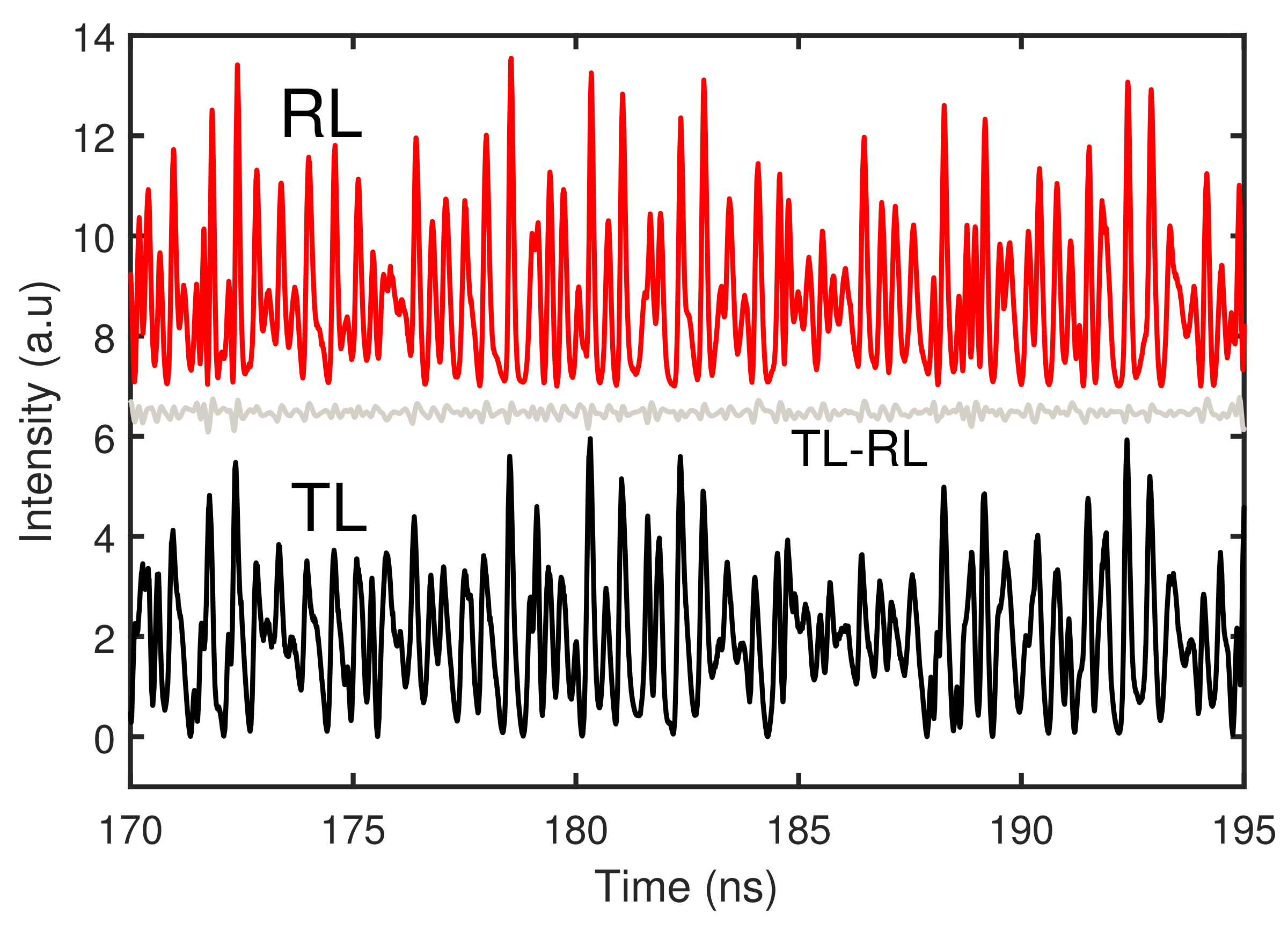
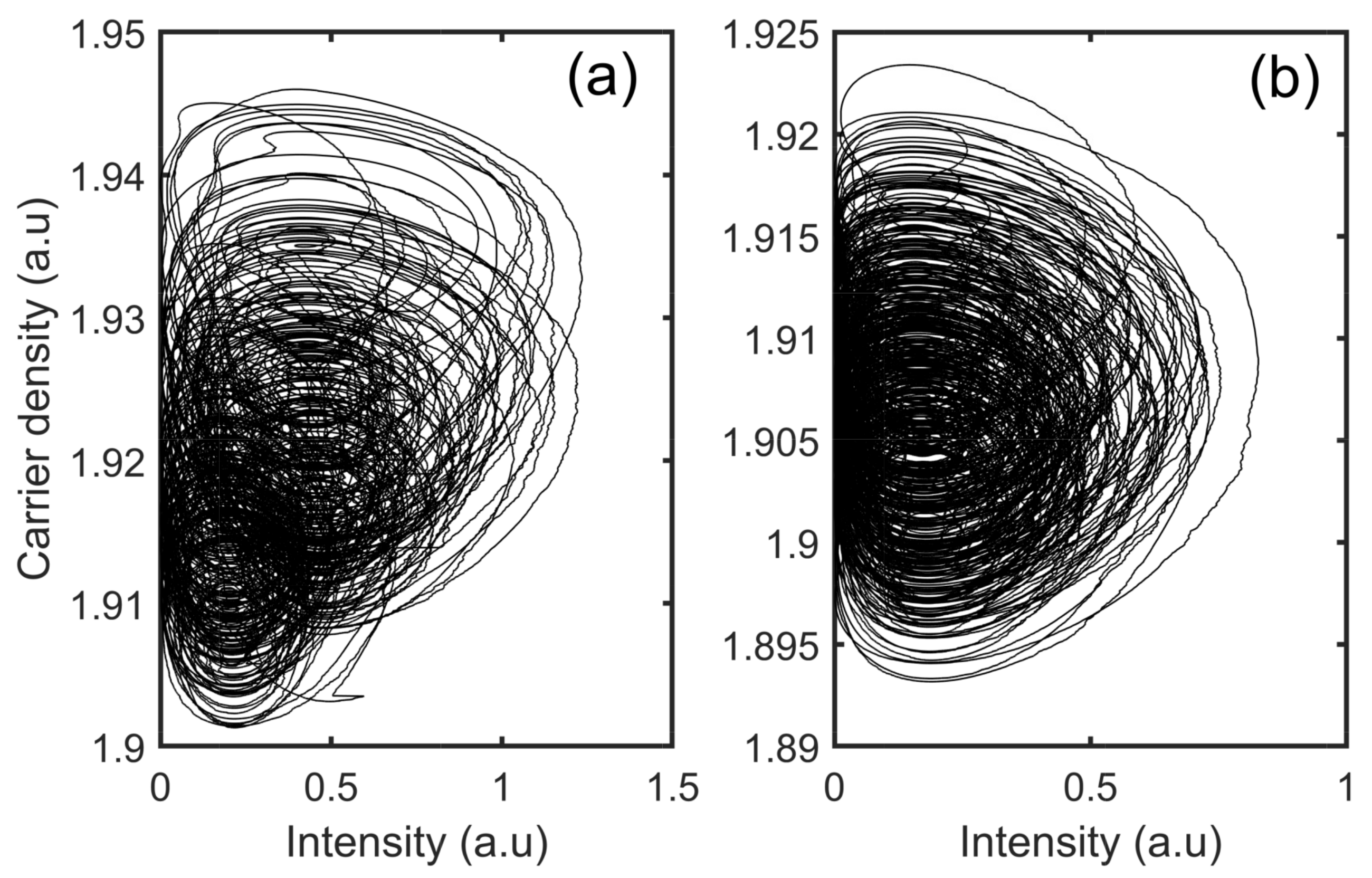
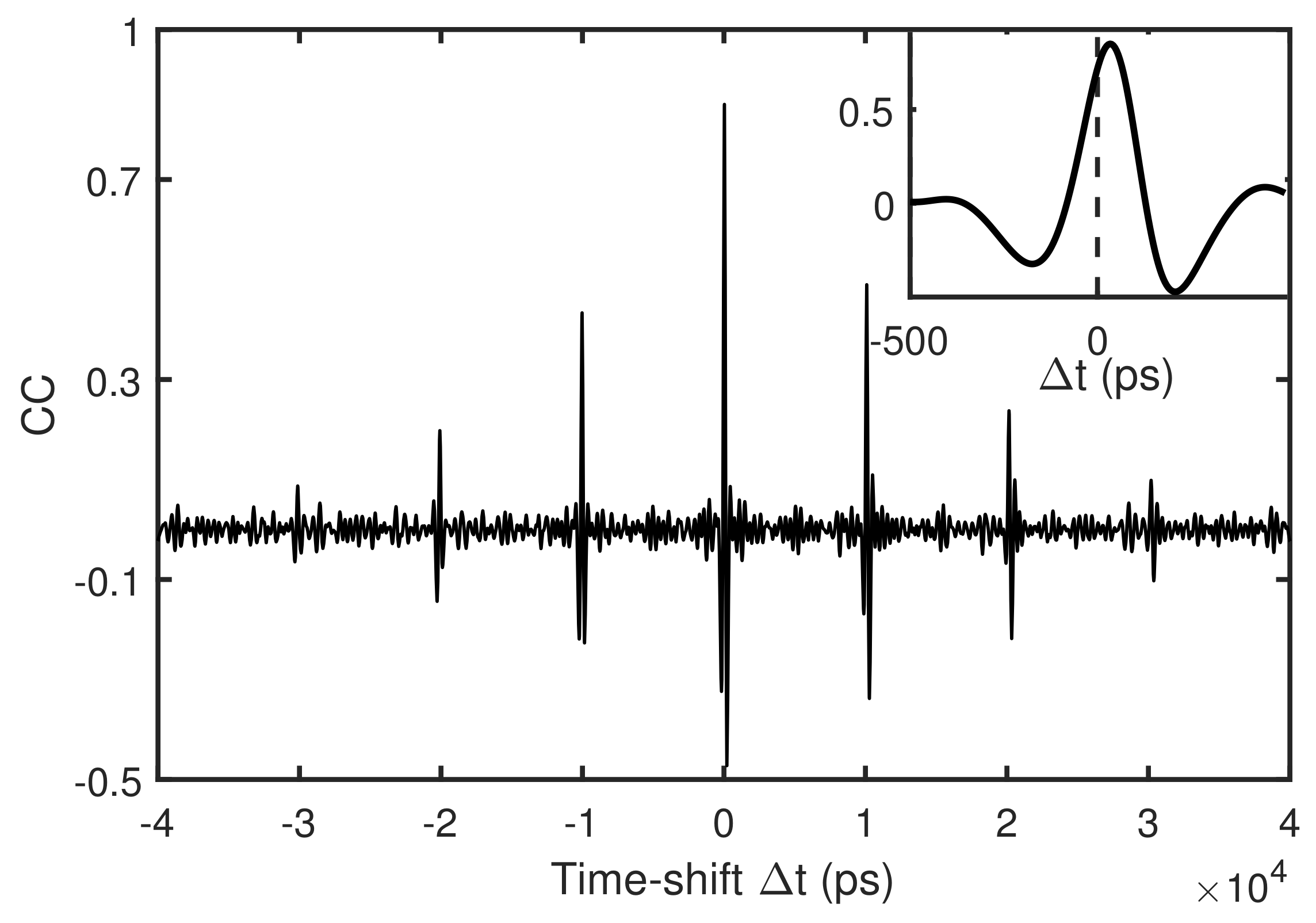
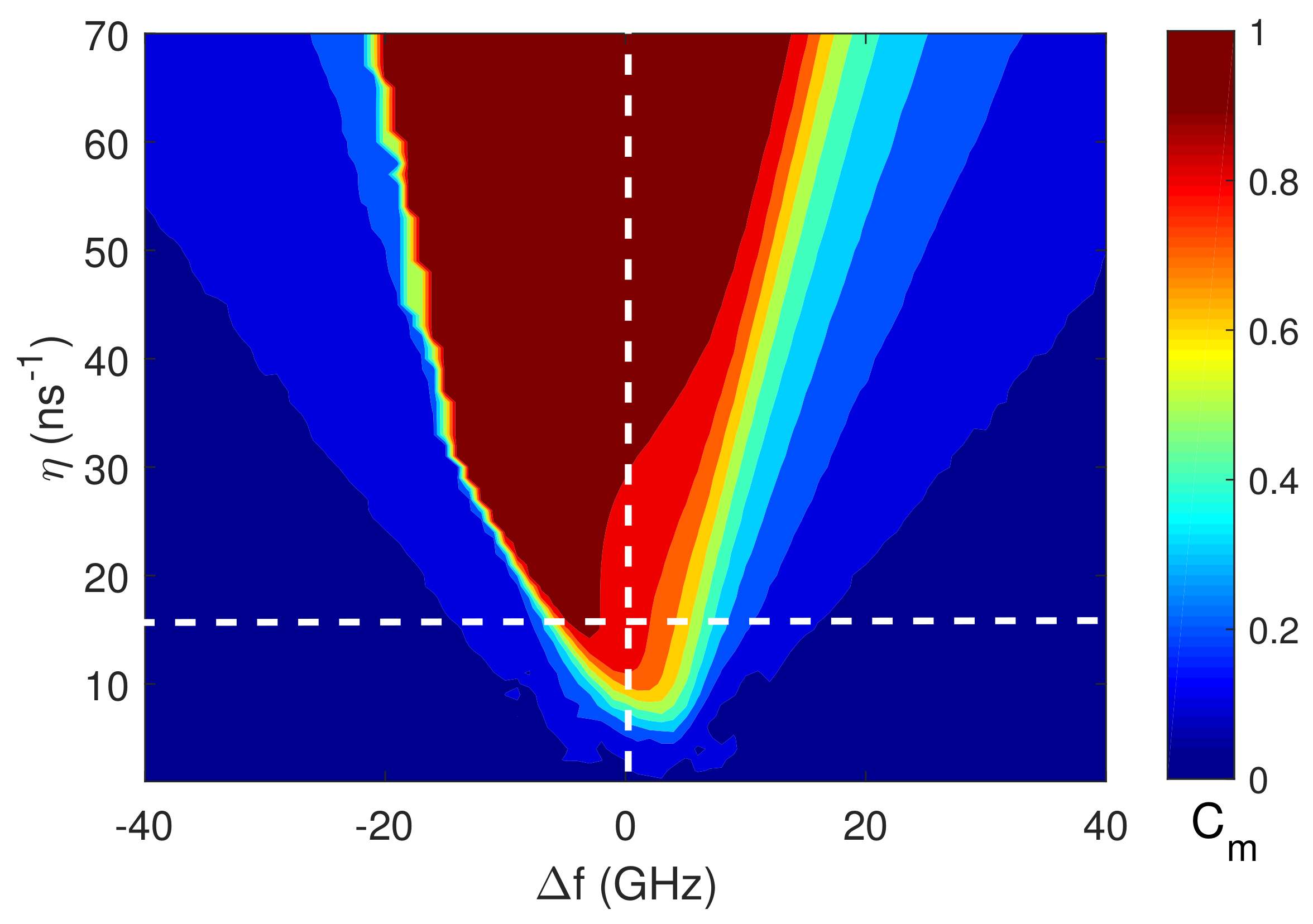
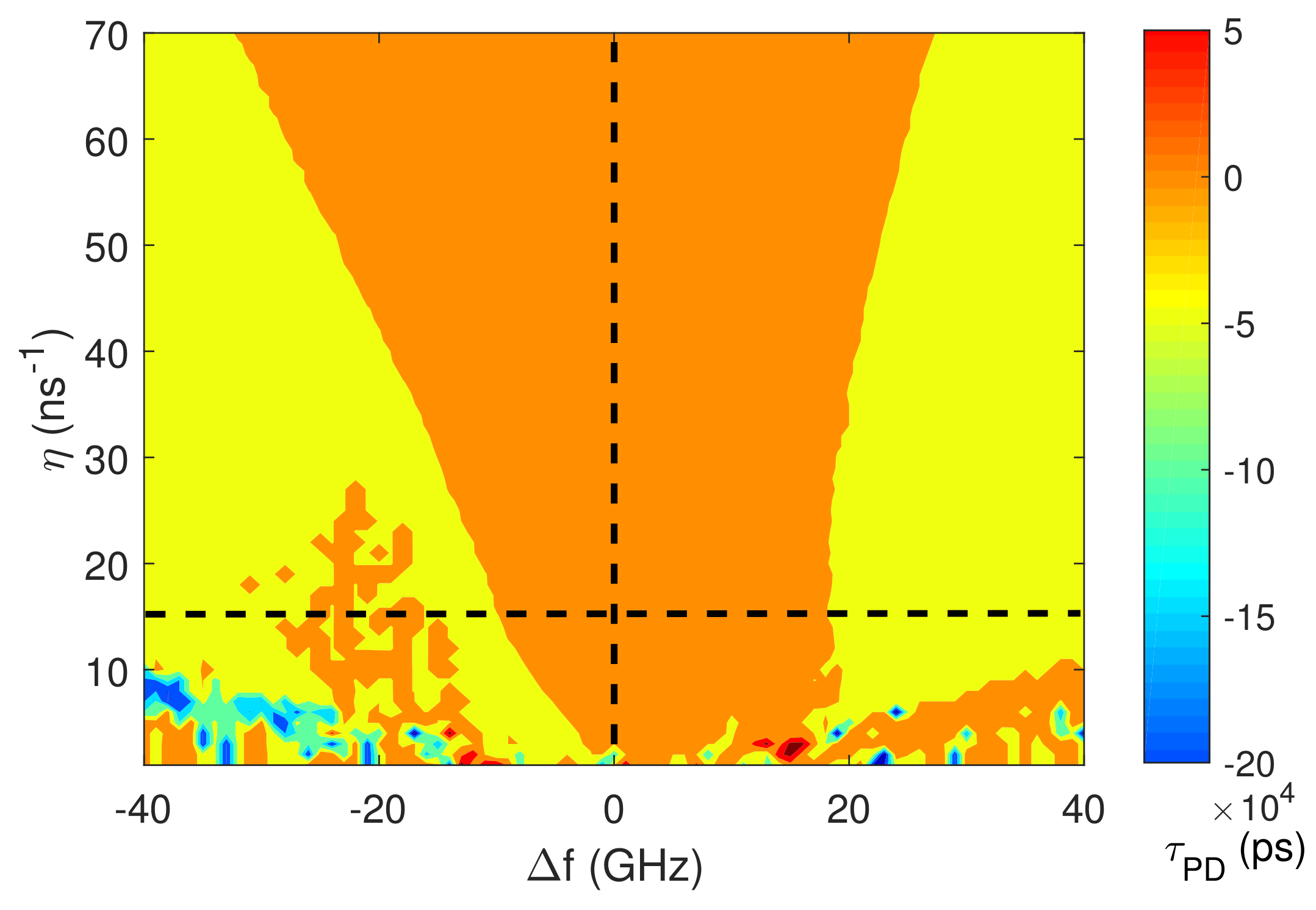
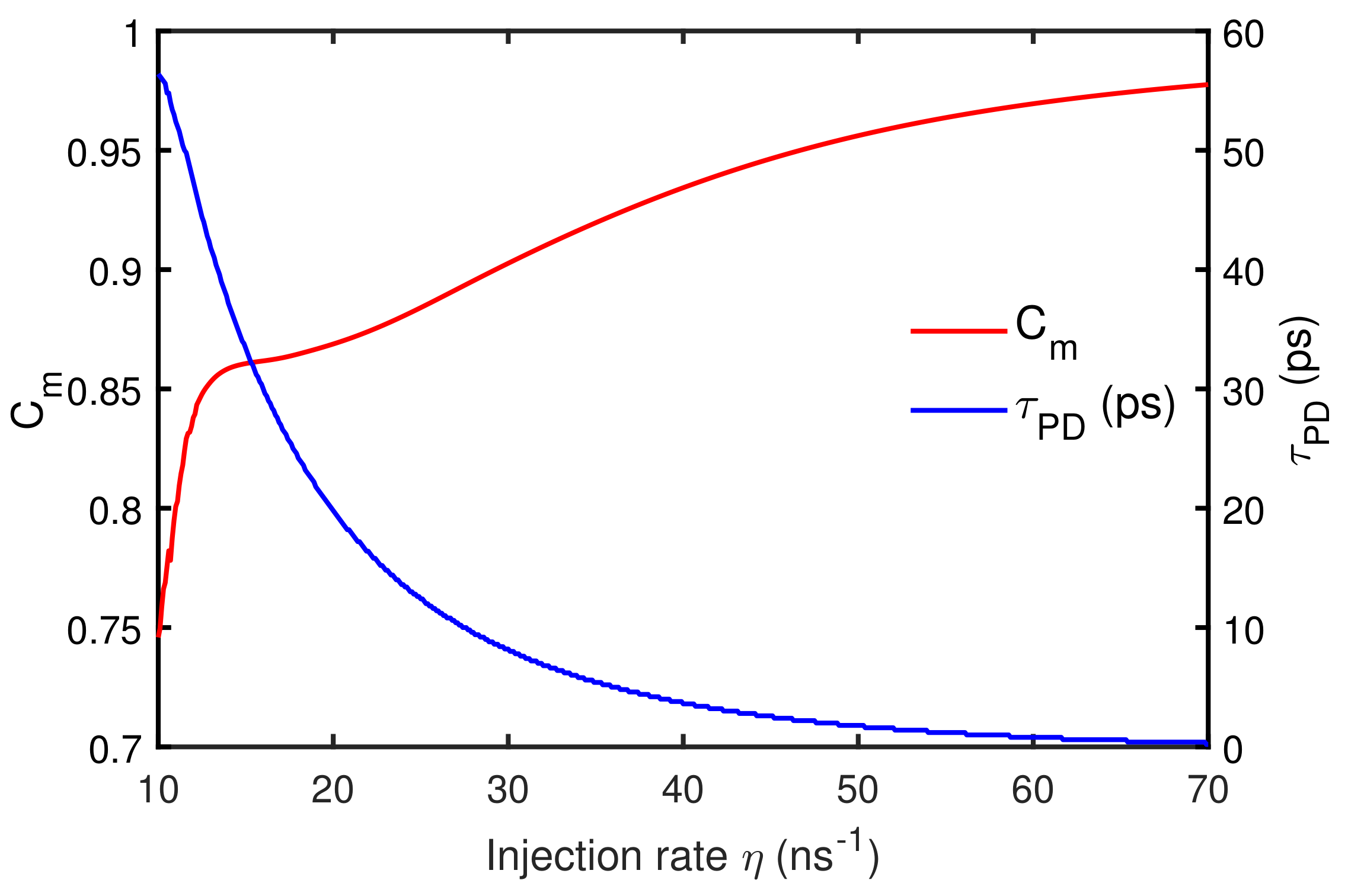
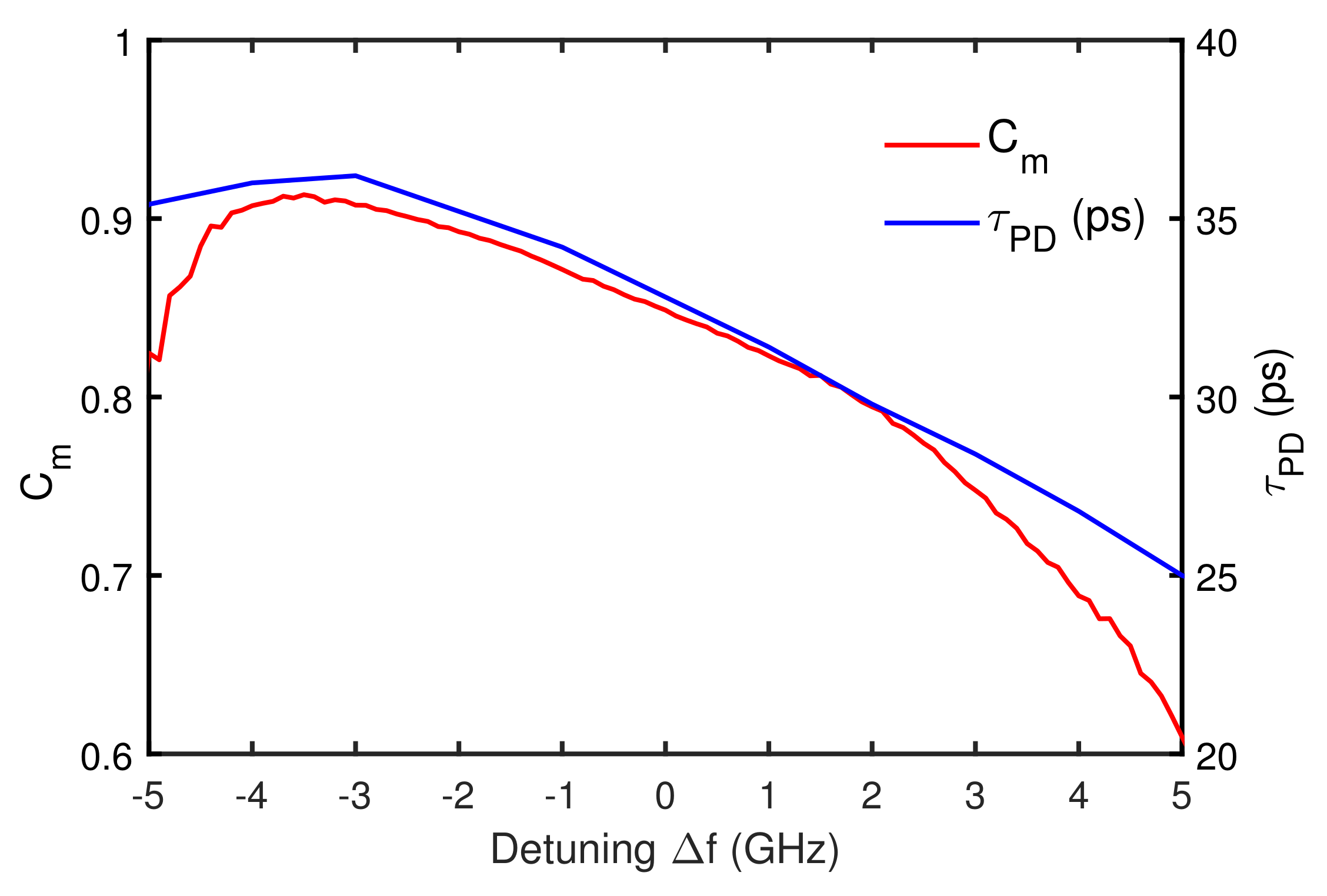
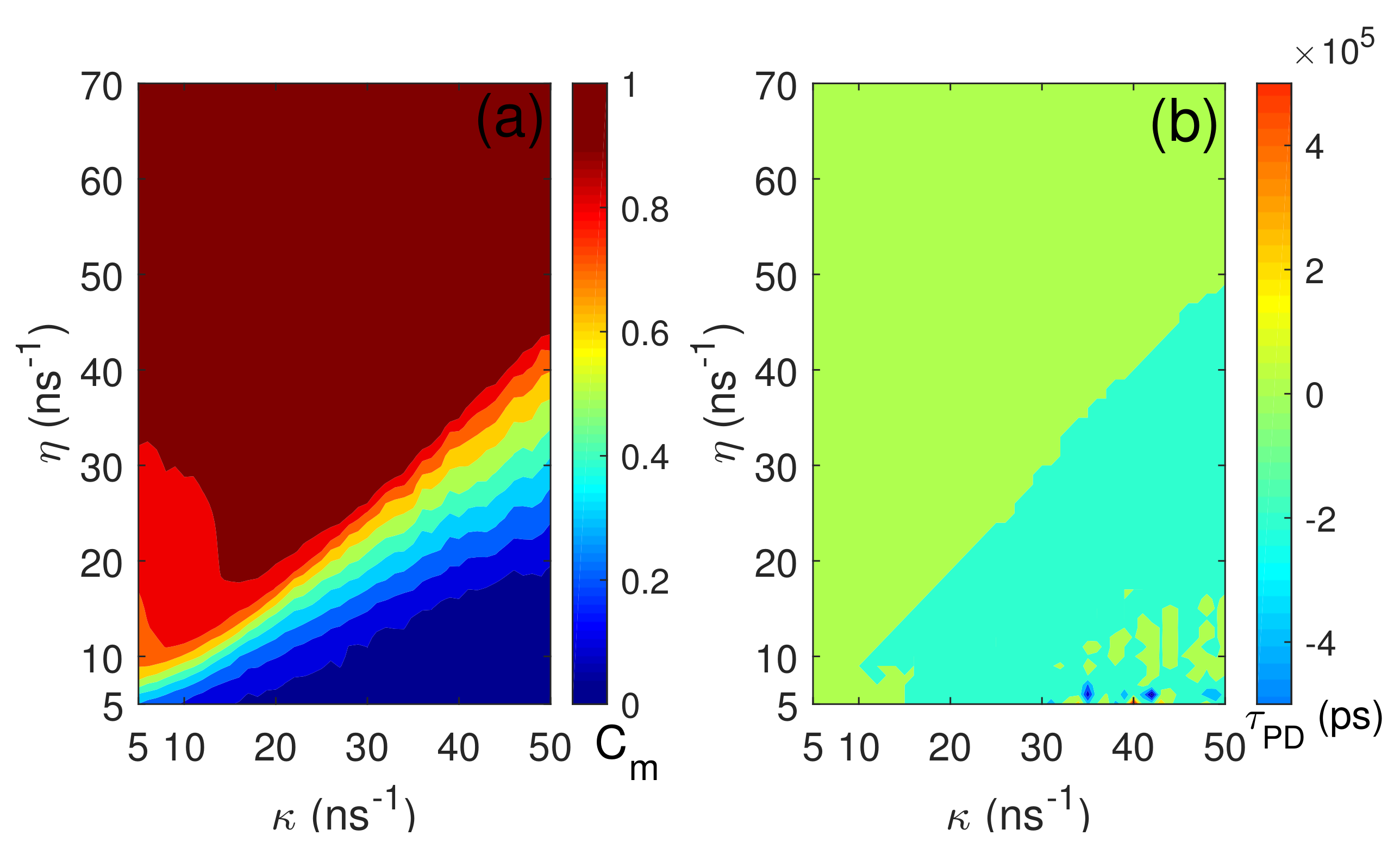
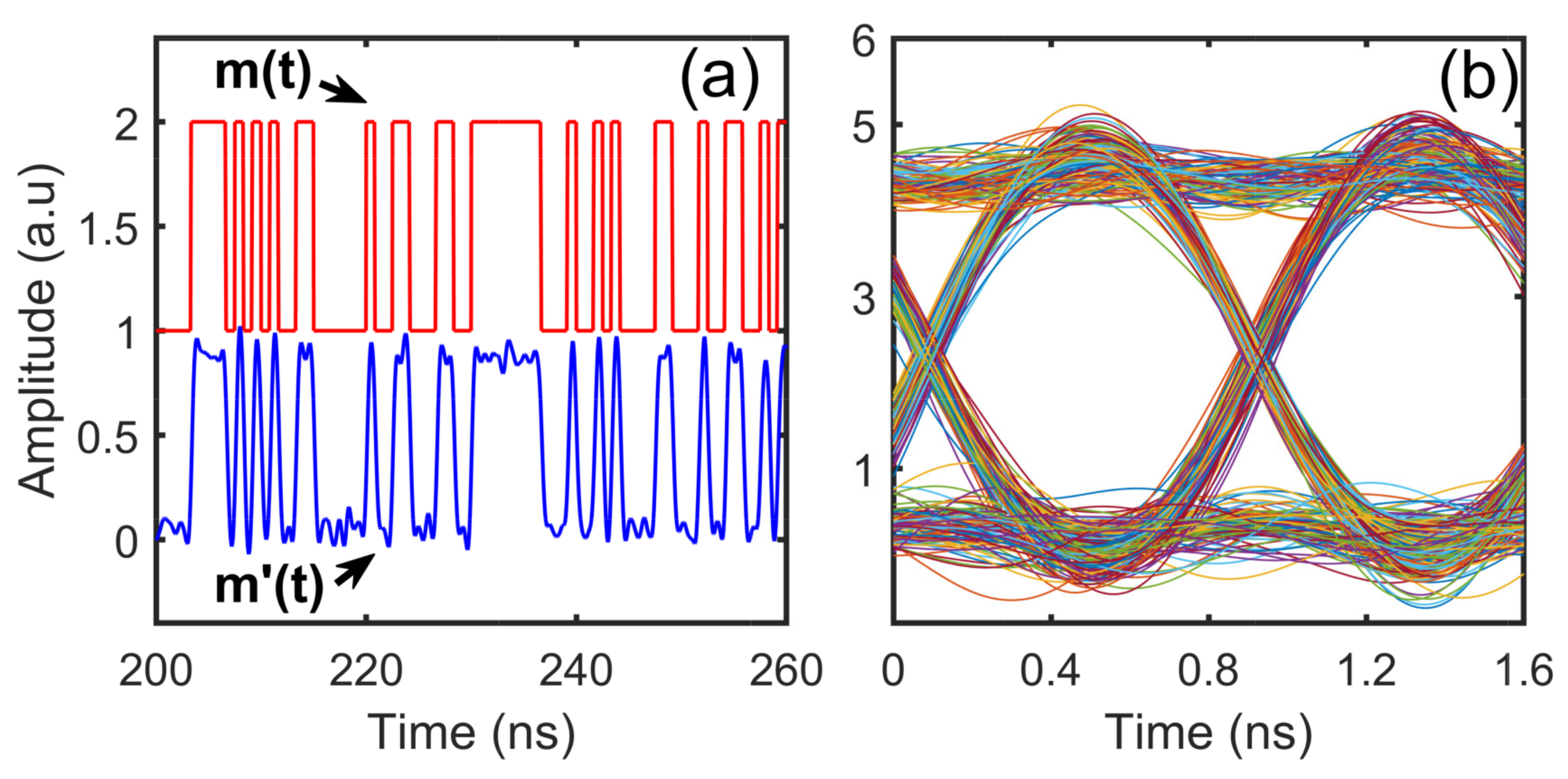
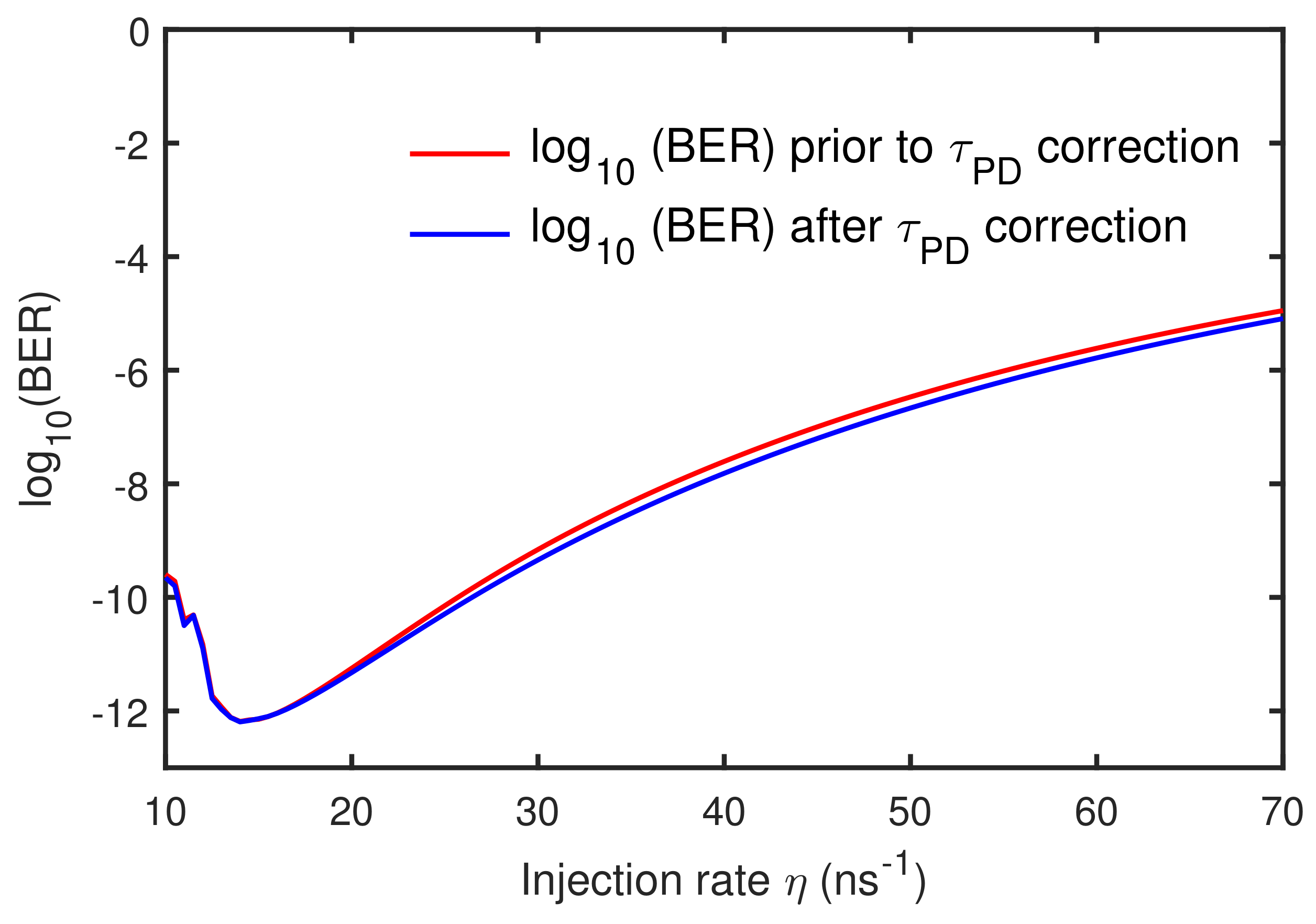
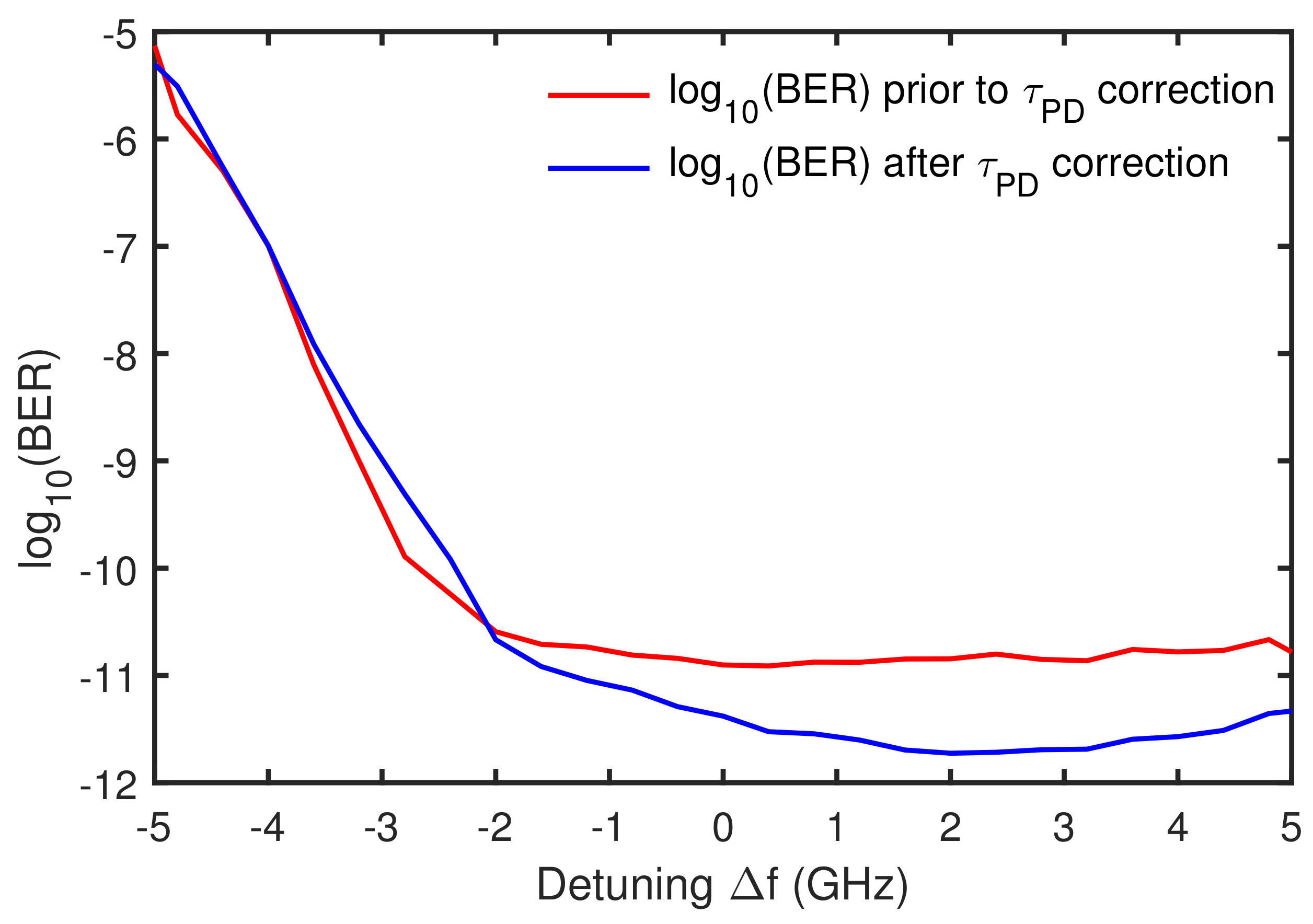
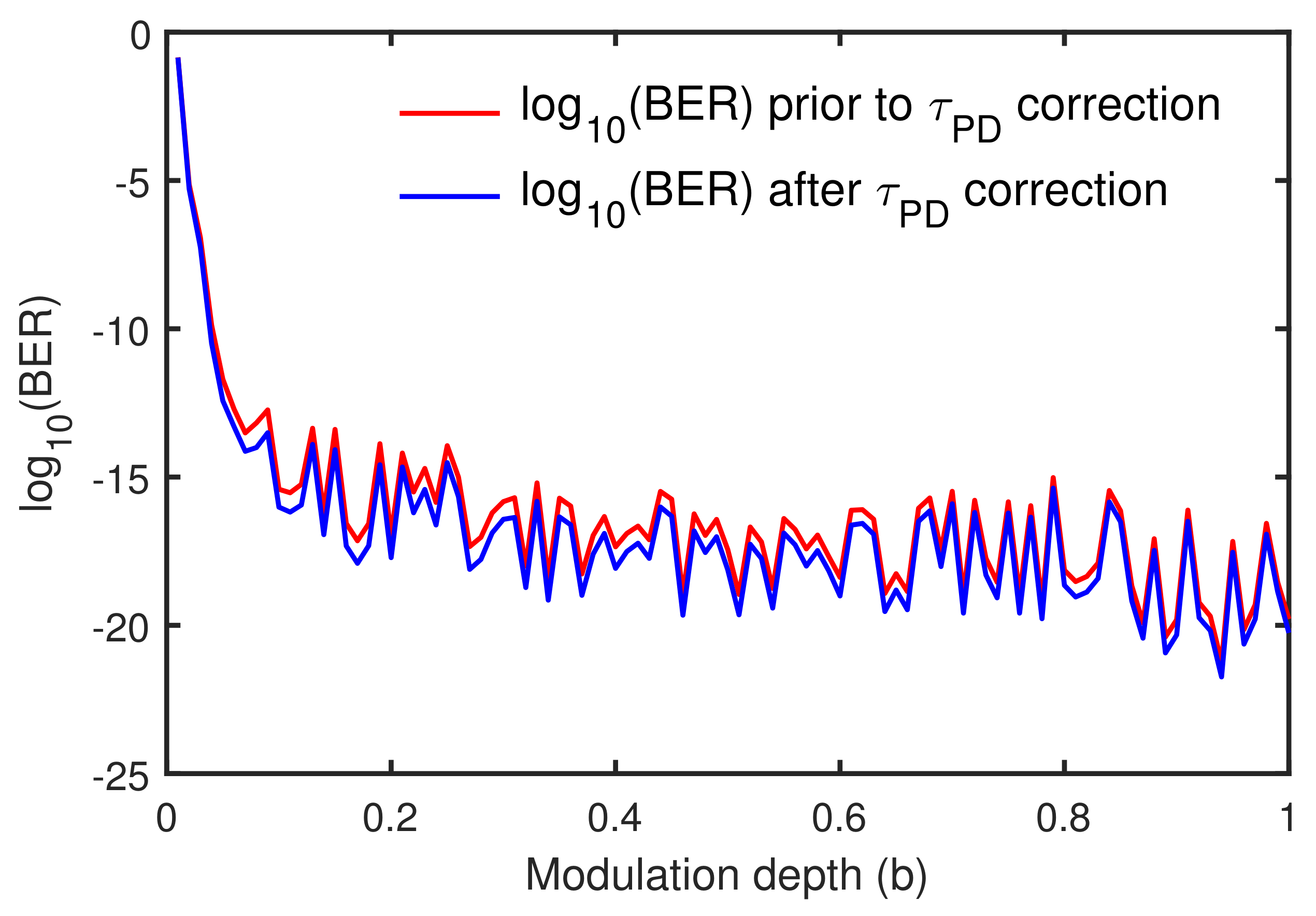
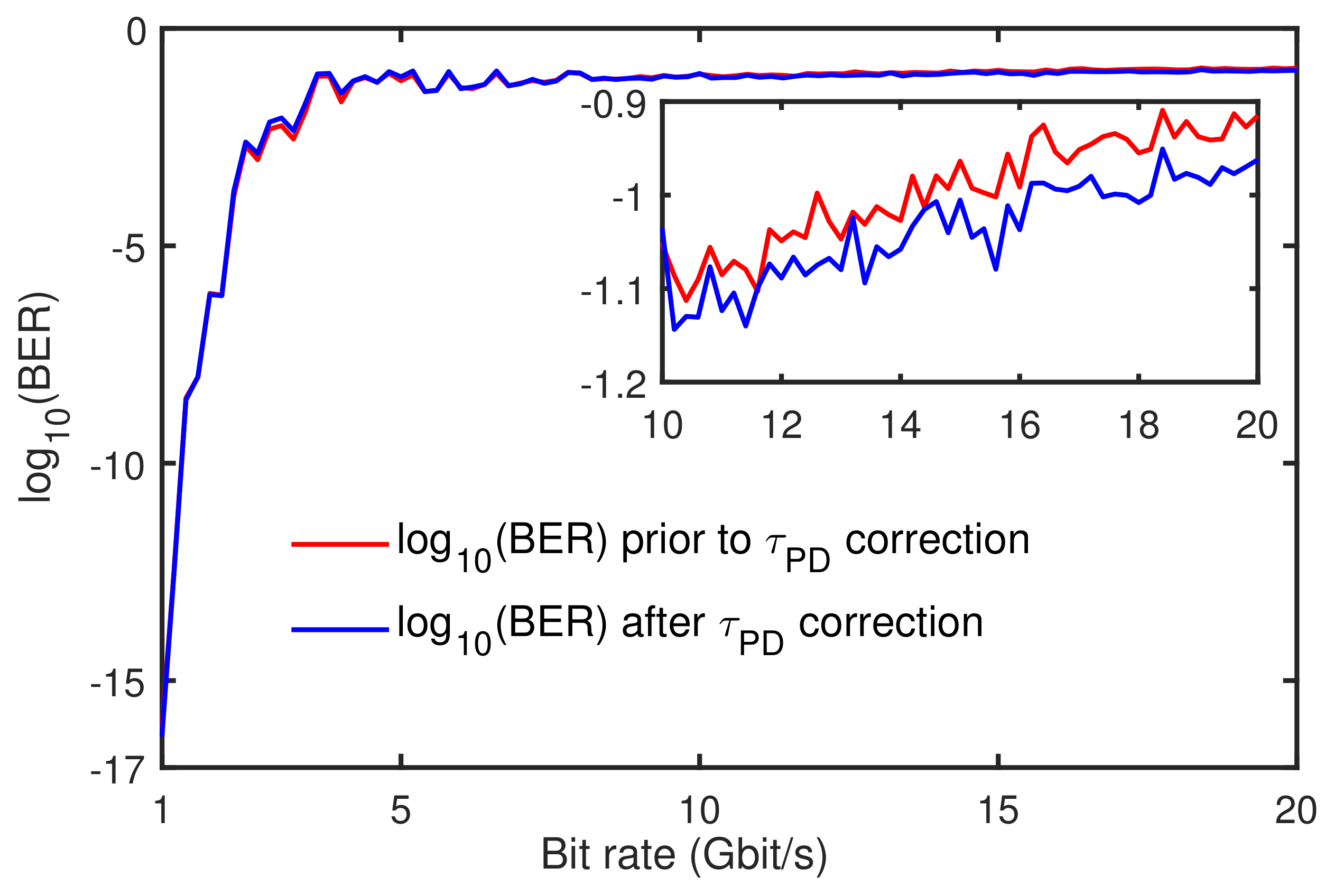
© 2019 by the authors. Licensee MDPI, Basel, Switzerland. This article is an open access article distributed under the terms and conditions of the Creative Commons Attribution (CC BY) license (http://creativecommons.org/licenses/by/4.0/).
Share and Cite
Jayaprasath, E.; Wu, Z.-M.; Sivaprakasam, S.; Hou, Y.-S.; Tang, X.; Lin, X.-D.; Deng, T.; Xia, G.-Q. Investigation of the Effect of Intra-Cavity Propagation Delay in Secure Optical Communication Using Chaotic Semiconductor Lasers. Photonics 2019, 6, 49. https://doi.org/10.3390/photonics6020049
Jayaprasath E, Wu Z-M, Sivaprakasam S, Hou Y-S, Tang X, Lin X-D, Deng T, Xia G-Q. Investigation of the Effect of Intra-Cavity Propagation Delay in Secure Optical Communication Using Chaotic Semiconductor Lasers. Photonics. 2019; 6(2):49. https://doi.org/10.3390/photonics6020049
Chicago/Turabian StyleJayaprasath, Elumalai, Zheng-Mao Wu, Sivaraman Sivaprakasam, Yu-Shuang Hou, Xi Tang, Xiao-Dong Lin, Tao Deng, and Guang-Qiong Xia. 2019. "Investigation of the Effect of Intra-Cavity Propagation Delay in Secure Optical Communication Using Chaotic Semiconductor Lasers" Photonics 6, no. 2: 49. https://doi.org/10.3390/photonics6020049
APA StyleJayaprasath, E., Wu, Z.-M., Sivaprakasam, S., Hou, Y.-S., Tang, X., Lin, X.-D., Deng, T., & Xia, G.-Q. (2019). Investigation of the Effect of Intra-Cavity Propagation Delay in Secure Optical Communication Using Chaotic Semiconductor Lasers. Photonics, 6(2), 49. https://doi.org/10.3390/photonics6020049





